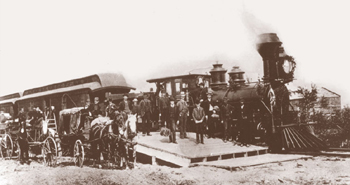| Français | Contact Us | Help | Search | Canada Site | ||||
| Home | A-Z Index | Scams/Fraud | Detachments | Publications | ||||



 |
|
| Home | |
| About the RCMP | |
| Organization | |
| RCMP Regions / Divisions | |
| Executive | |
| History | |
| Reports and Publications | |
| Musical Ride | |
| Best Practices | |
| Forms | |
| Priorities | |
| Programs and Services | |
| Newsroom | |
| Careers / Recruiting | |
Origins of the RCMP |
|
Settlement
In 1874, the Northwest Territories' white population numbered only a few hundred, mostly traders, missionaries, Hudson's Bay personnel, plus a few settlers. There were no railways, telegraph lines, regular mail services or newspapers. The new police posts at Fort Macleod, Fort Walsh and Fort Saskatchewan now attracted settlers. By 1878, there was a substantial village of several hundred persons adjacent to Fort Walsh.

Settlers congregated in and around the posts providing police with many
required services and trading with the natives who camped in the area.
Battleford grew rapidly after it was designated the territorial capital
in 1876. In the same year the telegraph linked it to Fort Pelly and Winnipeg.
In 1877, the line extended west to Edmonton which still had less than
1,000 inhabitants. In 1878, The Saskatchewan Herald, the Territories'
first newspaper, began its publication.
The number of settlers did not begin to increase steadily until railway
construction across the prairies during the period 1881- 1883. In 1877,
the first train was unloaded at Winnipeg, but construction across the
plains did not really get under way until four years later, when W.C.
Van Horne became Canadian Pacific Railway (CPR) General Manager. By October
1881, the track had arrived at Brandon. A year later it reached the new
territorial capital of Regina.
By August 1883, the line was through to Calgary. In its wake, there came
a steady stream of settlers. Many were construction workers. Towns soon
sprang up along its route - Medicine Hat, Moose Jaw, Maple Creek, Swift
Current - and older frontier posts, like Calgary, grew rapidly. In 1881,
the white population was about 7,000, in addition to 5,000 Métis
and 20,000-30,000 Indians. The census of 1884-5 showed the white population
had climbed over 23,000.
The hunting grounds of the First Nations and the need to control whiskey
trade had determined the early police posts' locations. Once the First
Nations relocated to their reserved land, the Force was gradually deployed
to police the growing settlements along the railway. In 1882, "Headquarters"
was moved to a more central location beside the Wascana Creek, on the
outskirts of Regina. In 1883, the government increased the NWMP's statutory
strength from 300 to 500 men, in order to meet growing responsibilities.
Detachments and divisions were soon established at the new urban centres
and railway settlements.
| Content created: 2002-09-01 Content revised: date |
Return to Top | Important Notices |